

Ever wondered how leading 24/7 operations strike the perfect balance between nonstop coverage and employee well‑being? The DuPont schedule 2025 might be the answer. In fact, according to a survey by MoniTask, 78 % of organizations report improved employee satisfaction after adopting it. Consider too that roughly 27 % of U.S. workers now operate on non‑traditional shifts , showing just how vital optimized scheduling has become.
This post will demystify what a DuPont work schedule is, why it’s gaining ground in industries like manufacturing, healthcare, and energy, and how HR and operations leaders can implement it smoothly. So, are you ready to transform your shift planning and workforce satisfaction? Let’s delve right in.
A DuPont schedule is a rotating shift pattern designed to ensure 24/7 coverage while offering employees extended periods of time off. It typically follows a four-week cycle with 12-hour shifts across four crews. Employees work 3–4 consecutive days, which can be in the first shift, second shift, or third shift, followed by 1–3 days off, including a full week off every month.
Popular in manufacturing, utilities, and chemical plants, the DuPont shift schedule balances operational efficiency with employee recovery time. Its unique structure minimizes burnout and improves coverage consistency. For HR and operations leaders, understanding this schedule is key to improving workforce morale, reducing fatigue, and meeting the demands of continuous operations.

Now, that you have a clear idea of define DuPont schedule, let’s take a look at a simple example to get a clear idea of how this schedule actually works.

The DuPont schedule follows a four-week rotating cycle designed to ensure 24/7 coverage while providing employees with a balanced mix of workdays and rest days. It typically involves four teams (A, B, C, D), each rotating between day and night shifts.
Below is a simplified breakdown showing how this duty schedule typically works for two teams—Team A and Team B, over a four-week cycle.
Week 1
Week 2
Week 3
Week 4
Now let’s break this down by teams to illustrate this 12 hour swing shift schedule:
Team A
Team B
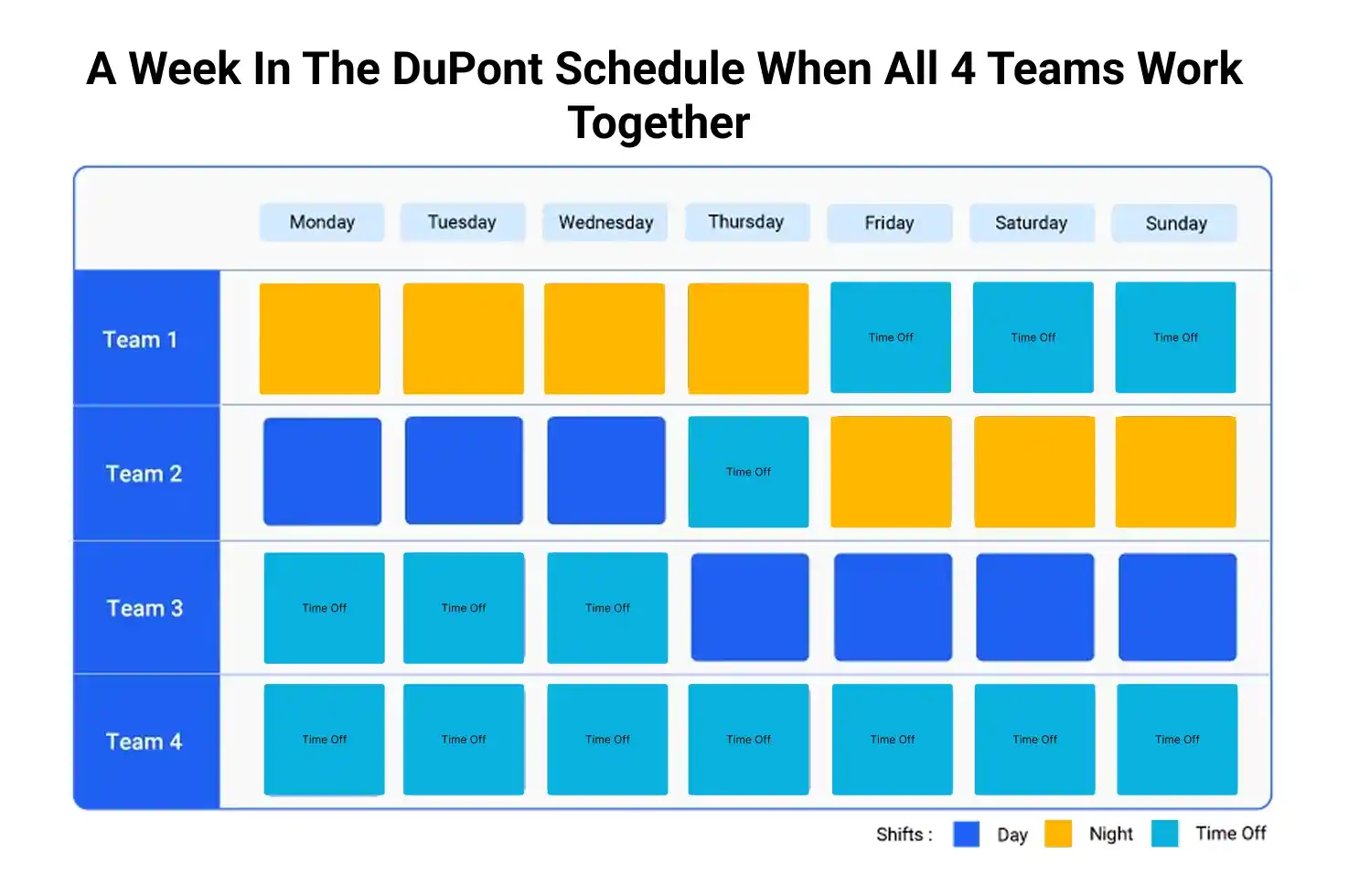
This rotation continues seamlessly across all four teams, ensuring no coverage gaps. It allows employees to work fewer days per month while still covering all 168 hours in a week, making it ideal for industries where uptime is mission-critical. Timekeeping with good time tracking app like Clockdiary is extremely important here to prevent overtime and to ensure compliance with labor laws.
Yes, the DuPont shift schedule can allow for built-in opportunities for overtime, especially during the heavier workload weeks. This also opens opportunities for double time pay. Since each employee works 12-hour shifts across a four-week rotation, the total hours per week vary—sometimes below the standard 40-hour threshold, and other times above it. This natural fluctuation creates room for legally compliant and operationally manageable overtime.
Here’s how overtime typically works within a standard DuPont schedule explained:
Week 1: Heavier Workload Week
| Days Worked | Shift Type | Hours |
| Mon – Thu | Night shift (4 days) | 48 hours |
| Fri – Sun | Off | 0 hours |
Week 2: Split Week
| Days Worked | Shift Type | Hours |
| Mon – Wed | Day shift (3 days) | 36 hours |
| Thu | Off | 0 hours |
| Fri – Sun | Night shift (3 days) | 36 hours |
Week 3: Standard Week
| Days Worked | Shift Type | Hours |
| Mon – Wed | Off | 0 hours |
| Thu – Sun | Day shift (4 days) | 48 hours |
Week 4: Full Rest Week
| Days Worked | Shift Type | Hours |
| Mon – Sun | Off | 0 hours |
Full Cycle Summary
| Week | Total Hours | Overtime Potential |
| Week 1 | 48 hours | 8 hours OT |
| Week 2 | 72 hours | 32 hours OT |
| Week 3 | 48 hours | 8 hours OT |
| Week 4 | 0 hours | None |
The DuPont schedule doesn’t just ensure coverage. It gives employers flexibility to offer fairly distributed overtime, while giving employees adequate rest or the option to pick up extra shifts voluntarily.
The DuPont schedule offers several compelling advantages for both organizations and their employees, making it a smart choice for 24/7 industries like manufacturing, energy, and emergency services.
These benefits make the DuPont shift work schedule a powerful strategy for US-based operations and HR managers aiming to balance efficiency, safety, and employee satisfaction in 24/7 environments.
While the DuPont schedule offers many operational benefits, it also comes with notable drawbacks that organizations must weigh carefully, especially in industries where health, safety, and employee satisfaction are top priorities.
Despite built-in rest days, employees work three to four 12-hour shifts in a row, often overnight. Extended hours and night work can lead to cumulative fatigue, especially during weeks with multiple consecutive shifts, making DuPont schedule bad for health.
According to the CDC, 12-hour shifts carry a 28% higher accident risk than 8-hour ones.
Rotating between day and night shifts within the same cycle can confuse the body’s natural circadian rhythm. Employees may struggle to adjust, resulting in poor sleep quality and chronic exhaustion.
Around 10–40 % of shift workers meet criteria for shift work sleep disorder, linked to chronic sleep loss and impaired productivity, again making DuPont schedule bad for health.
Although the DuPont 12 hour schedule includes full weeks off, working weekends and holidays can interfere with family life and personal plans. The inconsistent nature of shifts can be isolating for some workers, disrupting work-life balance.
In When: The Scientific Secrets of Perfect Timing, Daniel Pink emphasizes that time alignment with loved ones significantly impacts happiness and well-being.
If a team member calls out sick or takes leave, coverage becomes complicated due to the rotating nature of the schedule. Cross-training and on-call staff may be required, adding complexity.
DuPont’s predefined cycles leave little room for schedule customization. Employees who need flexible hours or predictable day shifts may find this 12 hours shift schedule restrictive.
Long shifts, sleep disruption, and fatigue can heighten the risk of accidents, especially in safety-sensitive environments like chemical plants or heavy manufacturing. Injuries jump by 28 % on 12‑hour night shifts compared to 8‑hour day.
While the Du Pont schedule aims to balance hours, weeks with heavy shifts can push employees into overtime territory, increasing labor costs and stress levels if not properly managed.
New employees or temporary workers may find the rotating pattern difficult to learn and adapt to, making onboarding and scheduling more resource-intensive.
In the end, we can say that the DuPont schedule requires careful planning to mitigate its downsides while leveraging its benefits.
Successfully implementing the DuPont schedule requires strategic planning, transparent communication, and ongoing support to ensure it meets both organizational and employee needs.
Start by evaluating your operational requirements.
Transparency is critical to employee buy-in.
Frontline leadership must be prepared.
Use tools and policies to roll it out smoothly.
Help workers thrive in the new system.
By following this phased approach, US-based operations and HR leaders can implement the DuPont schedule in a structured, employee-focused way, thus balancing productivity, compliance, and health.
Looking to streamline shift planning? Our free DuPont Schedule Template makes it easy to implement a 4-week rotating schedule across four teams. Designed for HR managers, operations leaders, and workforce planners, the DuPont shift schedule template provides a clear layout for 12-hour shifts, rest days, and rotation cycles.
It’s customizable, easy to use in Excel or Google Sheets, and ensures full 24/7 coverage with minimal manual work. Whether you’re new to the DuPont system or refining your current schedule, this 24 X 7 shift schedule template will save time and reduce errors. You can also make use of best Excel time tracking templates to monitor employee work hours in each shift.
Download DuPont Schedule Template Excel and Google Sheets to simplify your scheduling process and boost operational efficiency.
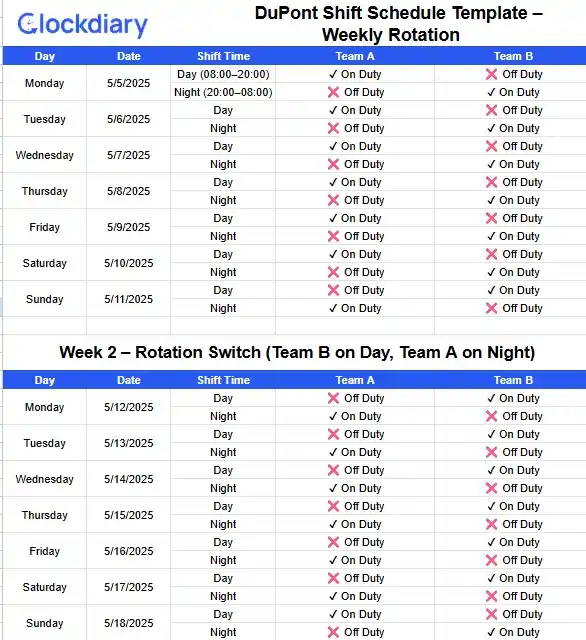
The DuPont schedule is ideal for industries that require continuous 24/7 operations, high efficiency, and consistent staffing. Here’s how different sectors leverage this model:
Hospitals, urgent care centers, and long-term care facilities use the Du Pont schedule to ensure round-the-clock patient care. It helps balance coverage needs while giving nurses and support staff predictable time off.
Factories with 24/7 production lines, especially those running automated or heavy machinery, benefit from reduced shift handovers and optimized workforce utilization.
Power plants, water treatment facilities, and energy distribution centers adopt DuPont to maintain nonstop service delivery with minimal downtime and reduced risk of outages.
Firefighters, paramedics, and dispatch centers often use this schedule to keep teams well-rested and ready for high-stress, time-sensitive situations. UK fire services, for example, pair 12-hour shifts with long breaks to balance rest and readiness.
Airports, shipping terminals, and freight companies need consistent manpower for handling cargo, deliveries, and flights. The DuPont work schedule helps meet demand without burning out drivers or ground staff.
From offshore rigs to refinery operations, these high-risk environments use DuPont to support safe, uninterrupted operations and efficient crew rotations.
In environments where continuous monitoring is crucial, DuPont ensures proper shift coverage while adhering to strict safety and compliance standards.
Mines operating deep underground or in remote locations use the DuPont shift schedule to maintain safe and reliable workflows while allowing workers extended rest days between shifts.
Large retail chains and fulfillment centers with extended or 24-hour operations may use a modified DuPont schedule to improve staffing efficiency and reduce overtime costs.
In all these industries, the DuPont schedule balances operational continuity with employee well-being, making it a go-to model for workforce planners in demanding environments.
The DuPont schedule can be a smart choice if your organization requires continuous 24/7 coverage and values employee rest and operational efficiency. It offers a balanced approach—longer shifts in exchange for extended time off, making it ideal for industries like manufacturing, utilities, healthcare, and emergency services.
However, it’s not for every workforce. The rigid rotation and 12-hour shifts may not suit teams needing flexibility or consistent day work. Flex schedule can be the best bet here. Before adopting it, evaluate your staffing needs, employee preferences, and safety requirements.
When implemented thoughtfully, the 2025 DuPont shift schedule can enhance employee productivity, reduce turnover, and improve work-life balance for shift-based teams.
Yes, while the DuPont schedule is a popular choice for continuous operations, several other shift patterns are also widely used across 24/7 industries. DuPont schedule alternatives have their strengths and trade-offs, depending on your staffing needs, fatigue risk, and operational complexity.
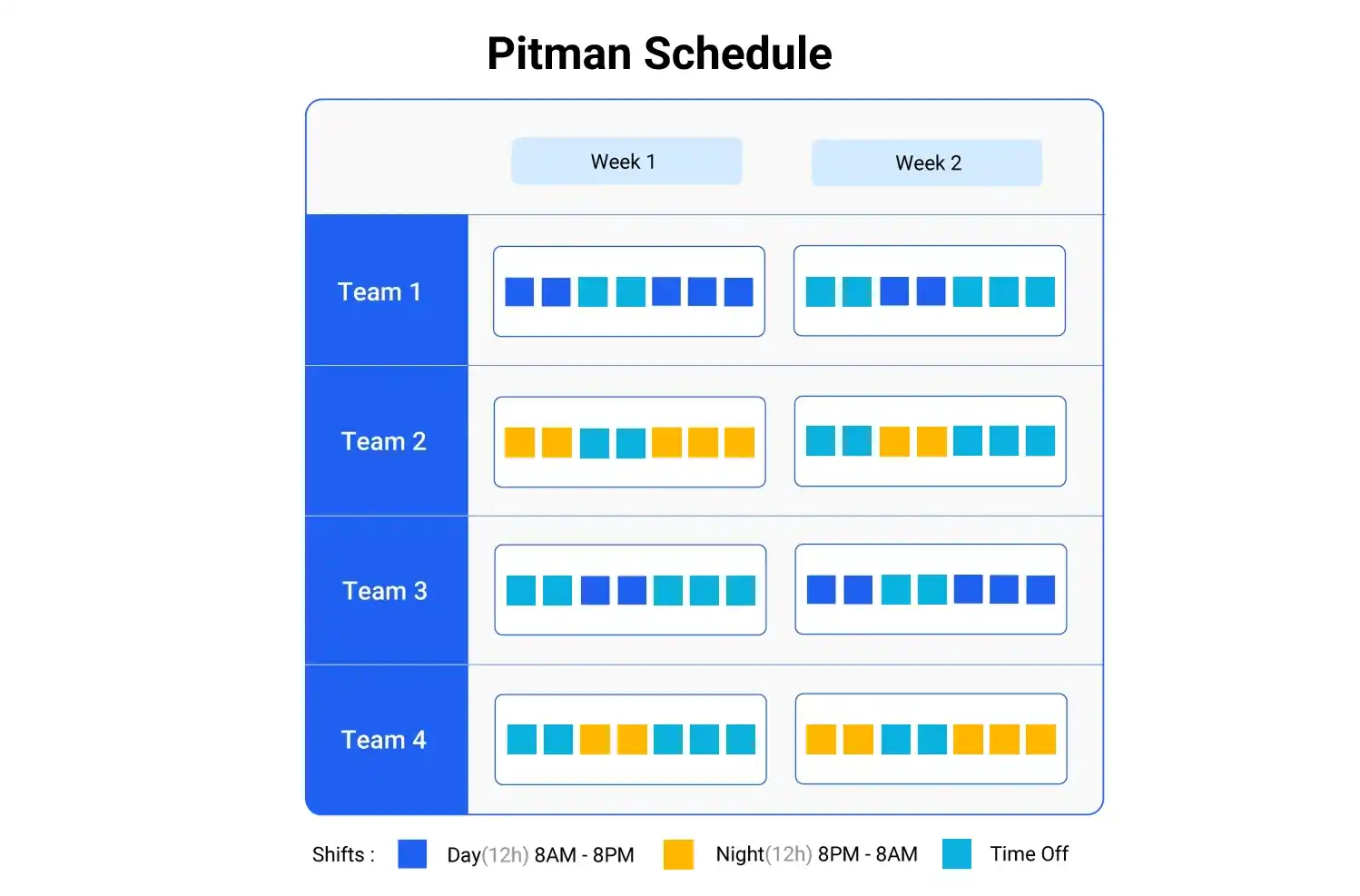
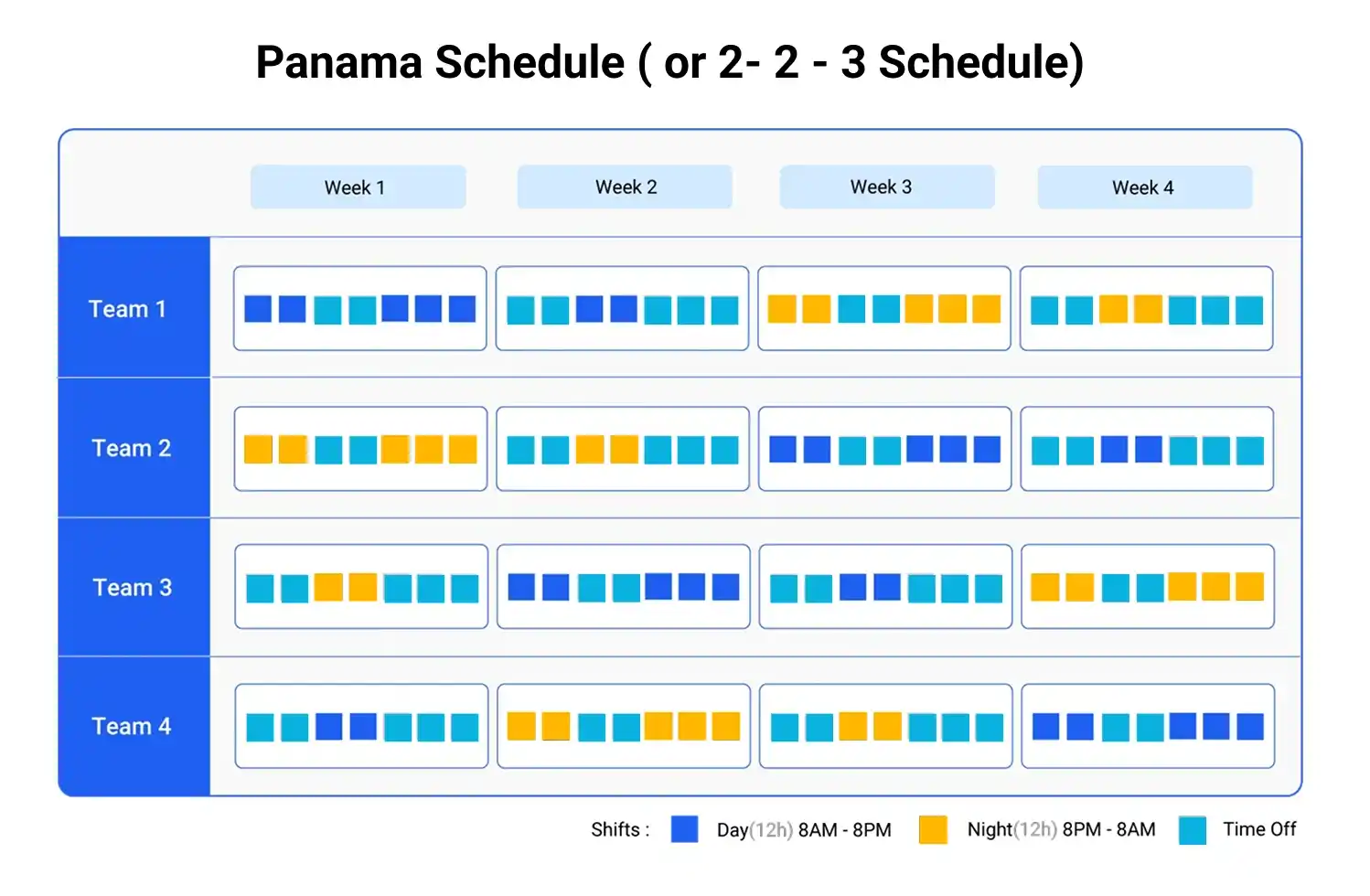
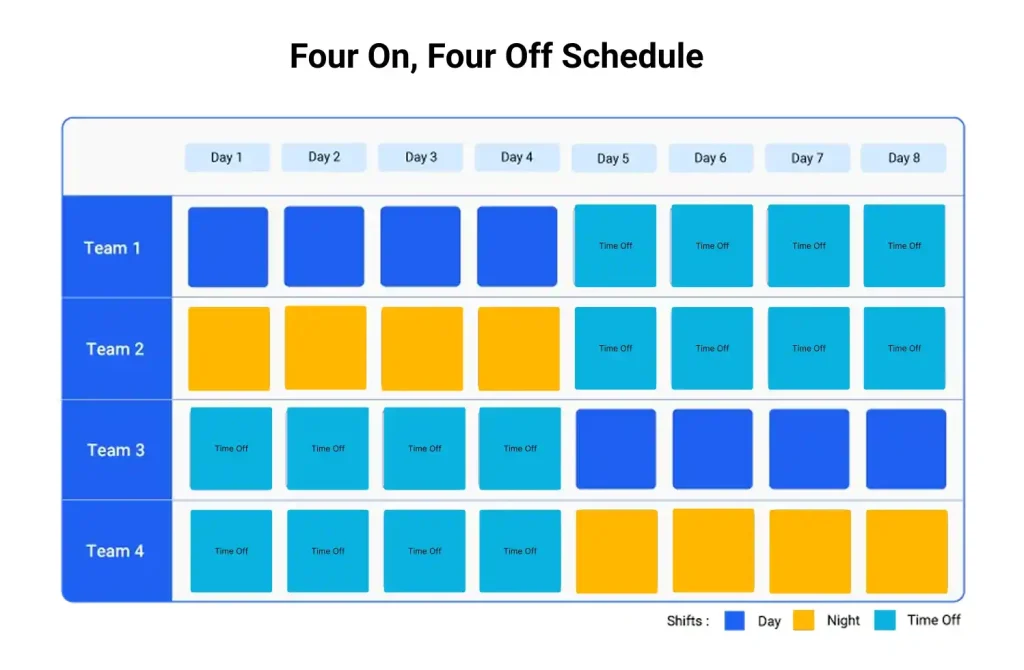
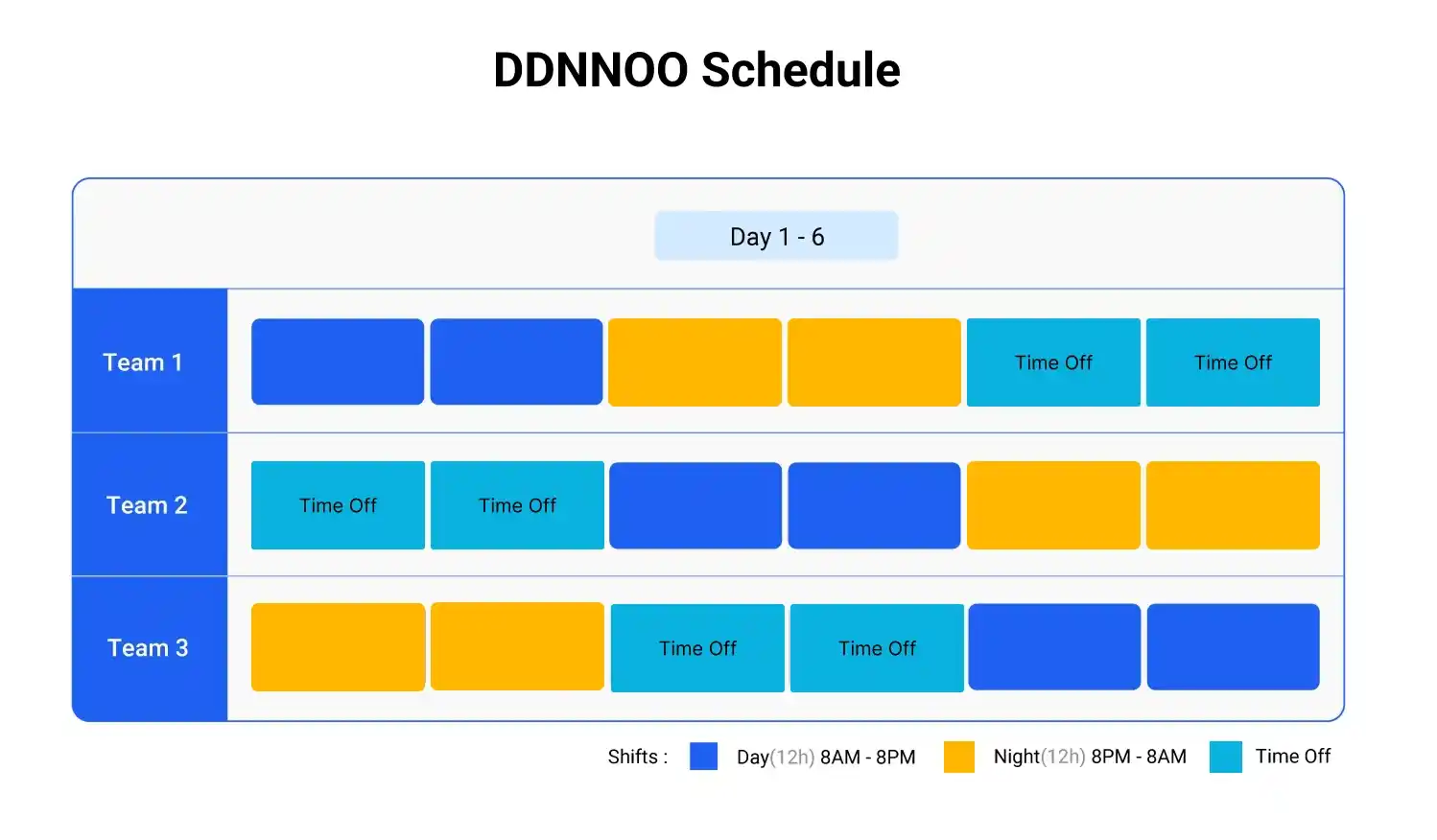
| Schedule | Shift Length | Rotation | Pros | Cons |
| DuPont | 12 hours | 4 – week | Week off every 28 days | Long shifts, rotation fatigue |
| Pitman | 12 hours | 2 – week | Every other weekend off | Repetitive, can lead to burnout |
| Panama | 12 hours | 2 – week | Built-in rest periods | Inconsistent rhythm |
| 4 – on 4 – off | 12 hours | 8 – day | Easy to manage | Day / night switch every cycle |
| DDNNOO | 12 hours | 6 – day | Short cycles, good rotation | High shift change frequency |
Each option has its ideal use case. Select based on employee needs, safety requirements, and operational goals.
In an era where operational continuity, employee well-being, and data-driven decision-making are essential to long-term success, the DuPont schedule stands out as a powerful workforce strategy. It’s built for businesses that run 24/7 like manufacturing, healthcare, logistics, and energy, balancing productivity with predictable time off. But implementing such a complex rotating schedule requires more than just spreadsheets. It requires smart technology.
That’s where Clockdiary, a leading AI-powered employee time tracking and workforce management tool, comes in. Clockdiary helps streamline the planning, execution, and monitoring of the DuPont schedule with powerful features designed to reduce manual work and optimize shift coverage.
With the Clockdiary employee monitoring app, implementing the DuPont schedule becomes simpler, smarter, and more scalable. By automating the complexities of workforce planning, you can stay agile, reduce errors, and make data-informed decisions, all while improving employee satisfaction and retention in today’s demanding business environment.
So, what are you waiting for? Get in touch with us to integrate this technological wizardry into your workforce and make DuPont work schedule implementation a breeze.

Frequently Asked Questions:
A modified DuPont schedule is a customized version of the traditional DuPont shift pattern, adjusted to better align with an organization’s unique staffing, operational, or employee needs. These modifications may include changes in shift length, rotation order, or rest days to improve flexibility, reduce fatigue, or comply with labor agreements.
An example of a DuPont schedule involves four teams rotating through a 4-week cycle, where each team works a mix of 12-hour day and night shifts followed by several days off, including a DuPont schedule 7 days off every cycle. This structure ensures continuous 24/7 coverage while balancing workload and rest periods for employees.
The DuPont schedule works on a 4-week rotating cycle involving four teams that alternate between 12-hour day and night shifts, ensuring continuous 24/7 coverage. Each team works a mix of 3- and 4-day shifts followed by rest days, including a full 7-day break every cycle to support recovery and work-life balance.
The DuPont schedule can support employee well-being by offering extended rest periods, including a full week off every 28 days, which helps with recovery and work-life balance. However, the long 12-hour shifts and rotating day/night cycles may disrupt sleep patterns and increase fatigue if not properly managed.
The DuPont schedule is named after the DuPont Company, which originally developed and implemented this rotating shift pattern in its manufacturing plants. It was designed to ensure continuous 24/7 operations while giving employees extended time off within each 4-week cycle.
A day shift is a work schedule that typically runs during standard daytime hours, usually from around 8:00 AM to 4:00 PM or similar. It is the most common shift and aligns with regular business hours, offering a more traditional work-life routine.
A 4-3-3-4 shift schedule is a rotating pattern where employees work 4 consecutive days, get 3 days off, work another 3 days, then have 4 days off. This schedule hours work typically repeats every two weeks and is used to provide 24/7 coverage while offering employees frequent extended breaks.